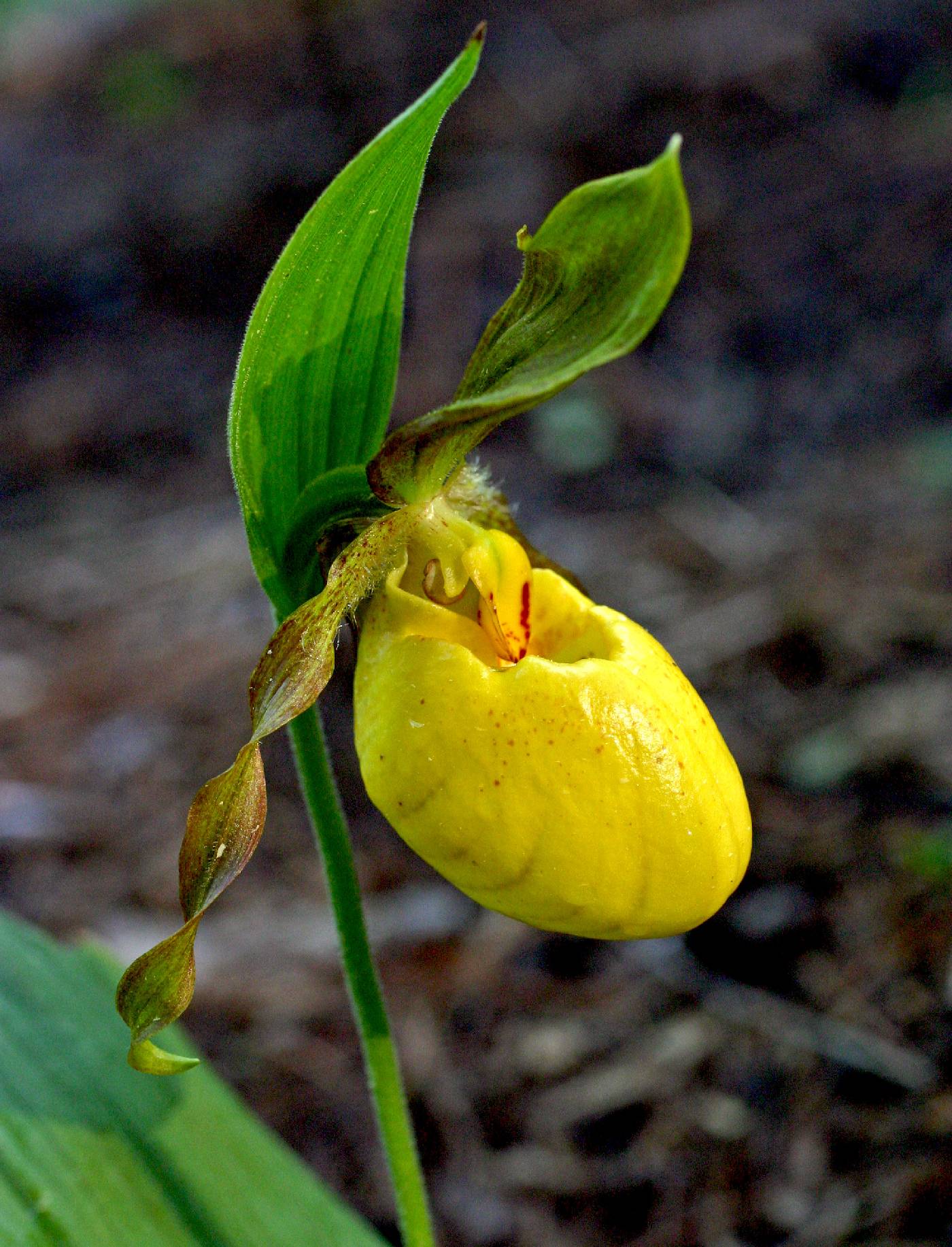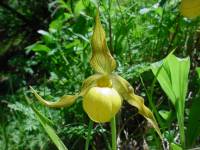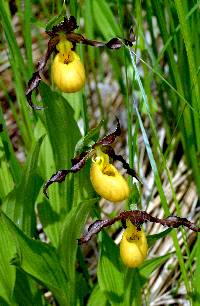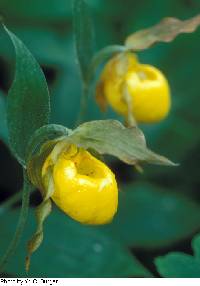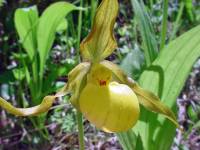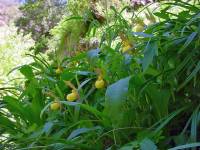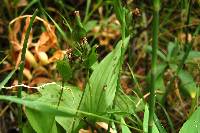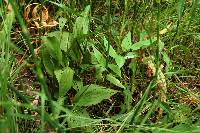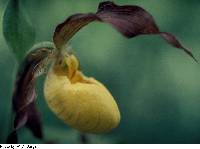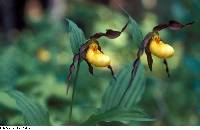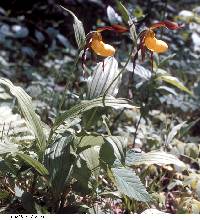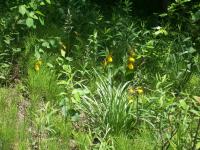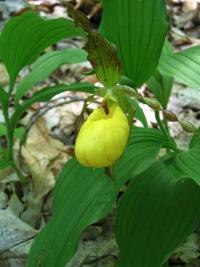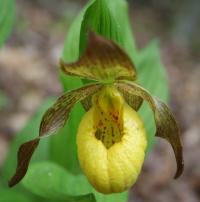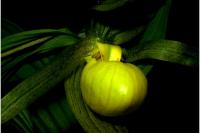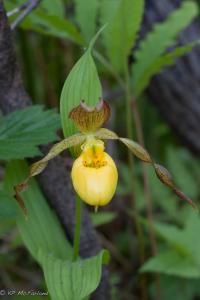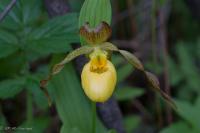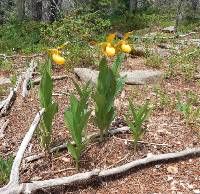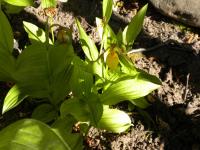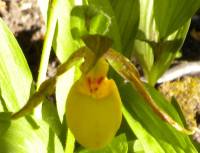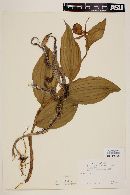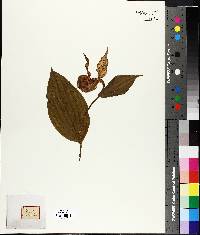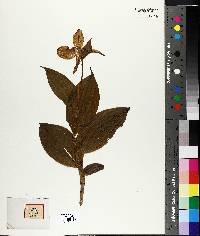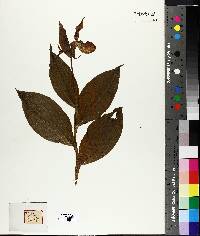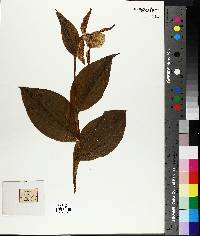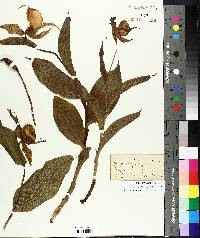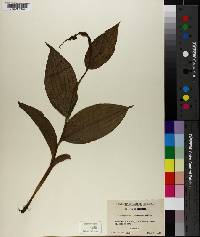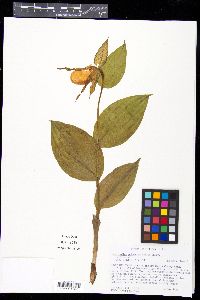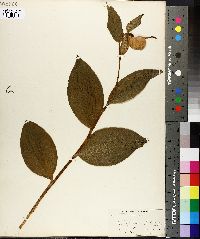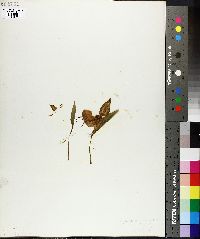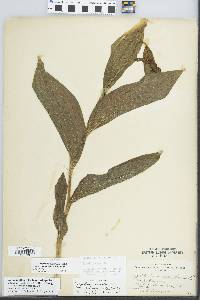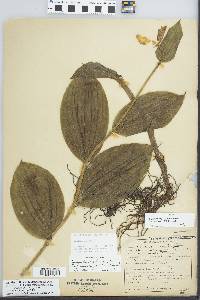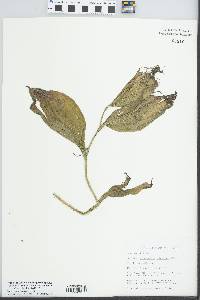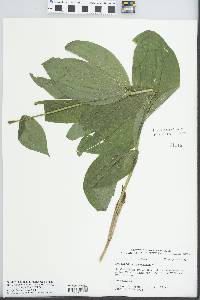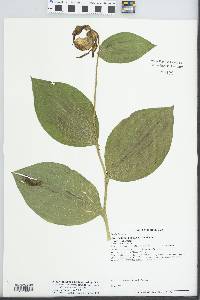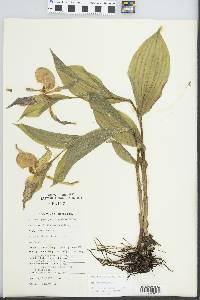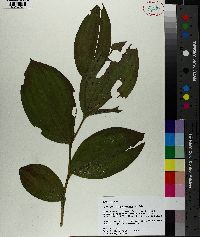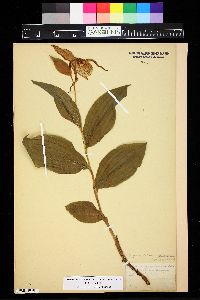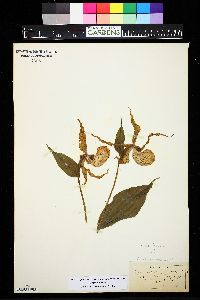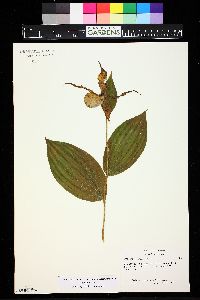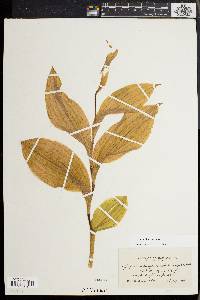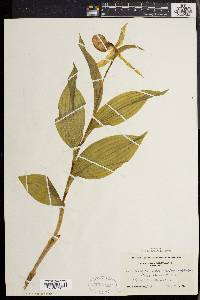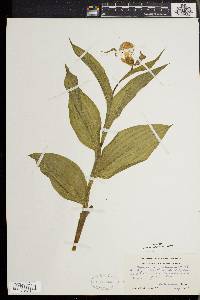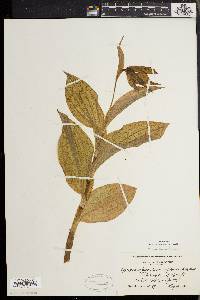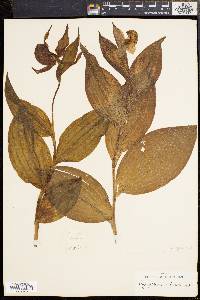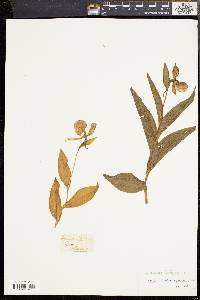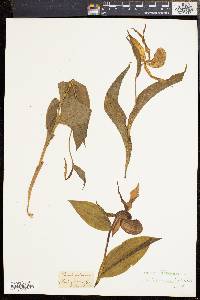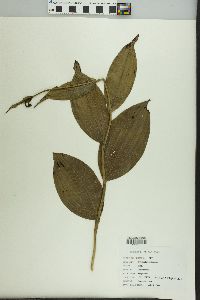
|
|
|
|
Family: Orchidaceae
Yellow Lady's-Slipper, more...lesser yellow lady's slipper
[Cypripedium calceolus L.] |
Plants erect, 70-700 cm. Flowers: sepals greenish or yellowish (often obscured by darker markings); dorsal sepal suborbiculate or ovate to ovate-lance-acuminate, 19-80 × 7-40 mm; lateral sepals connate; synsepal 11-80 × 5-34 mm; petals horizontal to strongly descending, same color as sepals, commonly spirally twisted or undulate, sometimes flat, linear-lanceolate to lance-ovate or oblong, 24-97 × 3-12 mm; lip rather pale to deep yellow, very rarely white, rarely with reddish spots or suffusion on adaxial external surface, 15-54 mm; orifice basal; staminode cordiform-ovoid, deltoid, lance-ovoid, or ovoid-oblong. Cypripedium parviflorum is extremely variable, reflecting individual phenotypic plasticity, infraspecific differentiation, and hybridization with related species. In particular, var. pubescens is difficult to delimit. In exposed situations, especially in calcareous soils, plants are low-growing with ascending, often narrow leaves and rather small flowers; in exposed boreal and arctic sites, plants and flowers may be very small with scarcely spiraled to flat petals. Such plants from Newfoundland were originally described as C. parviflorum var. planipetalum. When transplanted to less severe conditions, those plants often develop into larger plants with larger flowers of more common form; indeed, the holotype sheet of var. planipetalum includes a range in habit and floral morphology and includes a plant rather typical of boreal var. pubescens. The lips of smaller flowers often are markedly compressed laterally, with parallel sides, but when larger flowers are produced by the same plant, the proportions of the lip often change, the lip then being very broad below and tapering toward the adaxial surface (trapezoidal in cross section) or sometimes dorsiventrally compressed and broader than high. The southeastern var. parviflorum differs from var. pubescens primarily in flower size and color, and the two might be merely forms. Most works dealing with Cypripedium parviflorum have treated the primarily boreal var. makasin as var. parviflorum, either including all small-lipped plants within var. parviflorum, or in some cases restricting the name to the northern variety and excluding the southeastern plants described by Salisbury as C. parviflorum. Fernald´s original publication on C. calceolus var. parviflorum actually treated var. makasin, citing a description of that variety and clearly discussing the northern plant. Additionally, although geographically accommodating Salisbury´s plant, Fernald excluded most of the range of the southeastern var. parviflorum, thereby referring most plants of var. parviflorum to var. pubescens, and further restricted var. pubescens to the east, thereby assigning most plants of that variety to his northern var. parviflorum, i.e., var. makasin. Consequently, most published illustrations of var. parviflorum are in fact var. makasin. Variety parviflorum has been dealt with primarily in publications on the southeastern flora. In the east, var. makasin is quite distinct, but in the west it becomes difficult to separate from very small plants of var. pubescens that are common there; in that area, fragrance is often the least equivocal character. In the northwest it seems to merge with C. × columbianum, and in fact the northwestern elements of the species are only artificially accommodated within the variety. Very rarely plants apparently referable to var. makasin or var. parviflorum bear white lips. In some cases that may reflect past gene flow, but in others the plants appear to be color forms. Hybrids of Cypripedium parviflorum with C. candidum are C. × andrewsii A. M. Fuller, and different varietal parentages are recognized as nothovar. andrewsii [C. candidum × C. parviflorum var. makasin], nothovar. favillianum (J. T. Curtis) B. Boivin [C. candidum × C. parviflorum var. pubescens], and nothovar. landonii (Garay) B. Boivin [C. parviflorum var. parviflorum × C. × andrewsii nothovar. favillianum]. Hybrids of C. parviflorum with C. montanum are C. × columbianum Sheviak; the type was evidently derived from a cross with var. pubescens. Hybrids of var. pubescens commonly exhibit small lips and thus obscure varietal limits: in the northwest, C. × columbianum merges with var. makasin and var. pubescens; in the midwest, C. × andrewsii nothovar. favillianum may simulate var. parviflorum, and the delimitation of those two entities is unclear. Additionally, many plants of putative C. × andrewsii nothovar. favillianum suggest C. × columbianum. In general, those hybrids exhibit vegetative and floral morphology and color intermediate between those of their parents, or combinations of their parental characteristics. In particular, lips are commonly creamy, ivory, or yellow; often lips are yellow when the flower first opens and fade to white over the period of bloom. Consequently, different flowers on the same plant frequently exhibit a range of lip colors. Lip color furthermore sometimes varies from year to year in individual plants. Additionally, C. montanum and C. parviflorum var. makasin commonly contribute the dark coloration of their sepals and petals to hybrids with C. parviflorum and C. candidum, respectively. The apical margin of the orifice in C. candidum and C. montanum is typically acute, forming a sharp angle directed toward the apex of the lip. In C. parviflorum, this is a variable feature, but typically the margin is obtuse. Variation in this feature in yellow-lipped plants may in some circumstances aid the recognition of hybrids.
Perennial herb 10 - 100 cm tall Stem: one, erect, green, leafy, hairy. Leaves: two to five, alternate, erect to spreading, stalkless, green, 5 - 21 cm long, 1.6 - 14 cm wide, somewhat elliptic, non-toothed, some folded lengthwise, all strongly ribbed, and hairy. Inflorescence: of one or two, erect, terminal, stalked flowers closely subtended by a stalkless, sheathing, erect, green, hairy, leaf-like, 5 - 10 cm long, 1.5 - 4 cm wide, somewhat egg-shaped bract. Flowers: showy, fragrant, predominantly yellow, hairy, bilaterally symmetric with highly modified, very inflated, widely egg-shaped lip petal. Unlike other orchids, the reproductive parts of stamens and stigma are not fused into a column above the inferior ovary, but instead at the basal opening of the lip petal there are two separate anthers, one large, sterile, modified staminode, and a lobed stigma above the hairy inferior ovary. Sepals: greenish or yellowish, often with much darker markings (entirely so in one variety), three, but two lower fused together (except notch at tip) into a 1.1 - 8 cm long, 0.5 - 3.4 cm wide, hairy synsepal positioned behind and below lip petal. The remaining sepal is hairy, 1.9 - 8 cm long, 0.7 - 4 cm wide, egg- to lance-shaped or more rounded, and positioned uppermost above the inflated lip petal. Fruit: one or two, stalked, erect, widely ellipsoid, hairy capsules with remnant reproductive parts at tip, raised lengthwise angles, and stalk subtended only by basal sheath of bract. Root system: of slender, fleshy, fibrous true roots arising from rhizomes. Lateral petals: two, horizontal to strongly descending, same color as sepals, hairy, 2.4 - 9.7 cm long, 0.5 - 1.2 cm wide, typically spirally twisted or wavy, narrowly lance-shaped to more oblong. Lip petal: one, central, lowermost, pale to deep yellow (rarely white), 1.5 - 5.4 cm long, 1 - 3 cm wide, greatly inflated, pouch-like, more or less egg-shaped, and hairy. The basal opening (orifice) of the pouch with outer edge (opposite staminode) forming a blunt obtuse angle. Staminode: one, prominent, yellow with red or purple markings, egg- or heart-shaped to more or less broadly triangular, and positioned below upper sepal and pointing down to basal opening (orifice) of lip. On the back side of the staminode the two anthers are positioned on each side of the central lobed stigma. Similar species: Cypripedium parviflorum is composed of two varieties in our area, C. parviflorum var. makasin, which is distinguished by having the under surface of the sheathing bract sparsely and inconspicuously hairy or even hairless when young, smaller flowers (lip only 1.5 - 2.9 cm long), sepals and lateral petals extensively or entirely marked with dark reddish brown or maroon, and an intense and sweet floral scent. The other variety in our area, C. parviflorum var. pubescens, has more strongly clasping leaf bases, the under surface of the sheathing bract densely and obviously covered with silver hairs when young (later sometimes more hairless), larger flowers (lip 2 - 5.4 cm long), sepals and lateral petals unmarked or inconspicuously spotted or striped with reddish brown (rarely extensively blotched, and never uniformly dark), and the floral scent is faint and musty to rose-like. Flowering: late April to June Habitat and ecology: Uncommon, in a variety of habitats from open calcareous swales and marshy areas, woodlands with deep humus or leaf litter, or shaded boggy areas. The two different varieties tend to occur in different types of habitats. Occurence in the Chicago region: native Notes: There are three varieties of Cypripedium parviflorum in North America, and two of these occur in the Chicago Region. Much of the variations apparently have to do with ecological factors, especially the variations seen within the variety C. parviflorum var. pubescens. The nomenclature for this species and its varieties is confusing and complex in relation to the historical names applied to them. Most sources in the eastern United States (Voss 1972, Case 1987, Gleason and Cronquist 1991, Swink and Wilhelm 1994) use the species name C. calceolus L. instead of C. parviflorum as in the Flora of North America (Sheviak 2002). Most floras still use the name C. calceolus var. pubescens instead of C. parviflorum var. pubescens. The entity which is properly named C. parviflorum var. makasin is usually listed as C. calceolus var. parviflorum. This leads to confusion as to whether material should be called C. parviflorum var. parviflorum instead. In fact, most published illustrations for typical C. parviflorum var. parviflorum are actually depicting C. parviflorum var. makasin (see Case 2002, p. 505). The typical variety, C. parviflorum var. parviflorum, does not occur in the Chicago Region, but is distributed more east and south. Etymology: Cypripedium comes from combining the Greek word Kypris for Cypris (Aphrodite), the goddess of love and beauty; and either the Latin word pedis meaning foot, or possibly an orthrographic error for the Greek word pedilon meaning sandal or slipper; together translating roughly to beauty's or lady's foot or slipper, in reference to the inflated lip petal resembling a woman's slipper or shoe. Parviflorum means small flower, which refers to the relative small size of the flowers of this species. Author: The Field Museum Stem leafy, 2-8 dm; lvs ±sheathing, oval to lance-ovate, 6-20 cm, half as wide; fls 1 or 2, each subtended by an erect foliaceous bract; sep and lateral pet greenish-yellow to purplish-brown; upper sep ovate to lance-ovate, sharply acute, 3-8 cm; united lower sep somewhat narrower, 2-toothed at the tip; lateral pet lanceolate, 3-8 cm, usually twisted; lip yellow, usually veined with purple, 2-5 cm; 2n=20. Circumboreal, s. in Amer. to S.C., La., and N.M. May-July. Two vars. in N. Amer., partly isolated by differences in pollinators associated with fl-size. Gleason, Henry A. & Cronquist, Arthur J. 1991. Manual of vascular plants of northeastern United States and adjacent Canada. lxxv + 910 pp. ©The New York Botanical Garden. All rights reserved. Used by permission. |
|
|
|

